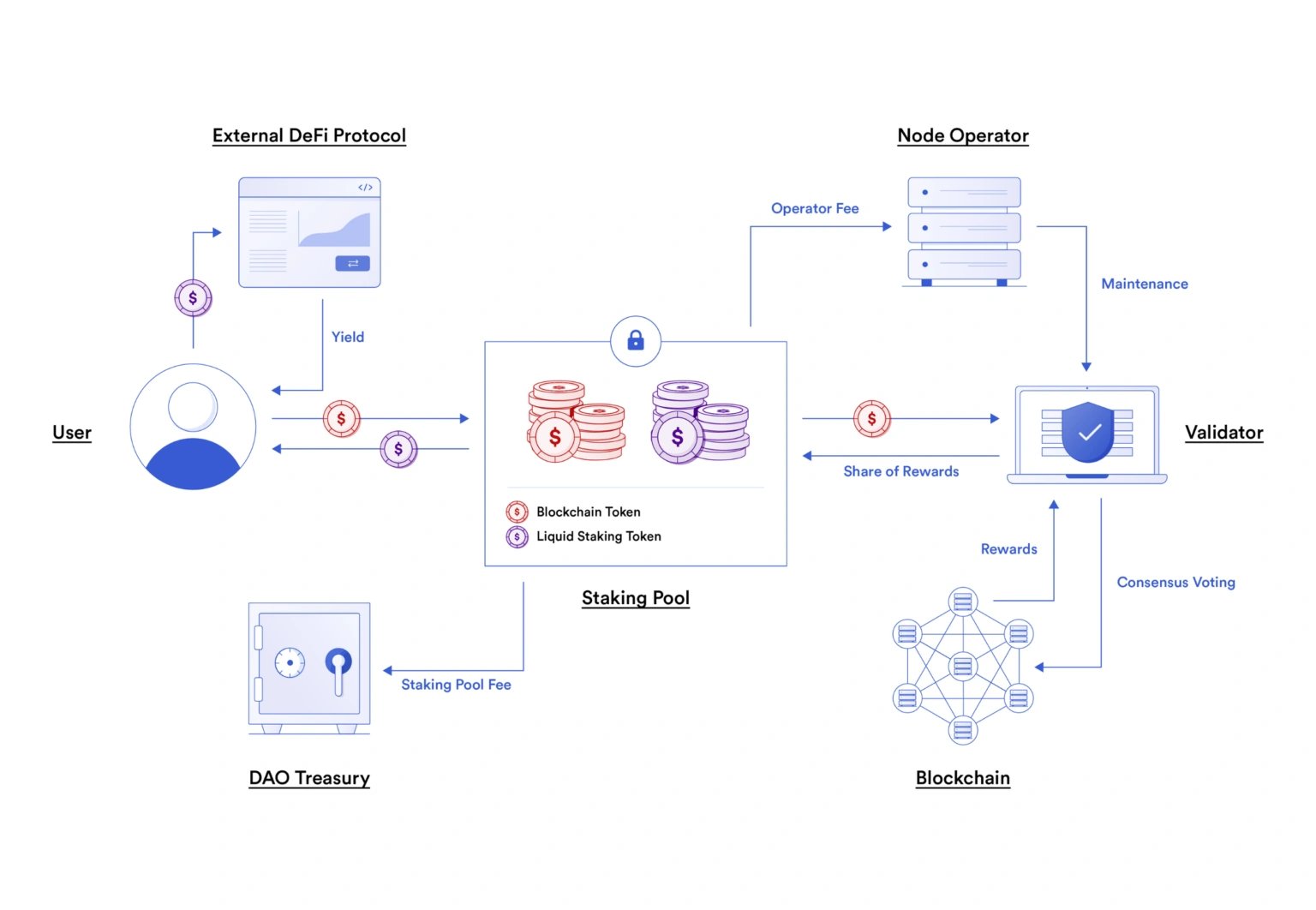위키 구독하기
Share wiki
Bookmark
Liquid Staking
에이전트 토큰화 플랫폼 (ATP):에이전트 개발 키트(ADK)로 자율 에이전트 구축
Liquid Staking
**유동적 스테이킹(Liquid Staking)**은 블록체인과 암호화폐에서 사용자가 토큰을 스테이킹하면서 동시에 유동성을 유지하고 거래할 수 있도록 하는 스테이킹 솔루션입니다. 이는 토큰을 네트워크 검증에 잠금 해제하고 보상을 얻는 스테이킹과 자산을 자유롭게 거래할 수 있는 유동성 유지 사이의 간극을 해소합니다. [1][2]
개요
유동적 스테이킹은 사용자가 토큰을 잠그지 않고도 스테이킹 보상을 얻을 수 있는 스테이킹 유형입니다. DeFi 에스크로 계정에 자금을 보관하는 것을 포함합니다. 사용자는 스테이킹 기간 동안에도 자금에 접근할 수 있으므로 프로토콜이 유동적입니다. [2][3][7]

유동적 스테이킹 메커니즘은 블록체인 네트워크와 DeFi 플랫폼에 따라 다르지만, 유동성 풀, 탈중앙화 거래소(DEX) 또는 기타 DeFi에서 사용할 수 있는 스테이킹된 토큰의 표현을 통해 작동합니다. 이는 토큰을 스테이킹하는 사용자에게 유동적 스테이킹 토큰(LST)을 발행하여 수행됩니다. LST는 스테이킹된 토큰을 나타내는 토큰이며, 다른 DeFi 애플리케이션에서 거래, 이전 및 사용할 수 있습니다. 사용자의 스테이킹된 토큰을 풀링하고 기본 블록체인의 검증자에게 위임하여 작동합니다. 검증자는 네트워크 보안 및 트랜잭션 처리를 담당합니다. 그 대가로 스테이킹 보상을 받습니다. 그러면 유동적 스테이킹 플랫폼이 이러한 보상을 LST 보유자에게 배포합니다. 유동적 스테이킹을 통해 사용자는 토큰을 스테이킹하면서도 유동성에 접근할 수 있습니다. [6][7][8][2]
유동적 스테이킹 플랫폼
Lido Finance
Lido Finance는 DeFi(탈중앙화 금융) 플랫폼으로 Ethereum(이더리움)의 유동적 스테이킹을 제공합니다. 사용자는 ETH를 Lido에 스테이킹하고 staked Ether (stETH)(스테이킹된 이더(stETH)) 토큰을 받습니다. 이 stETH(stETH) 토큰은 스테이킹된 ETH를 나타내며, 스테이킹 보상을 계속해서 얻을 수 있고, DeFi 애플리케이션이나 거래소에서 거래 가능합니다. 사용자는 stETH를 ETH(이더리움)로 쉽게 전환하여 유동성을 확보할 수 있습니다. Lido는 Ethereum(이더리움), Polygon(폴리곤), Solana(솔라나)를 지원하며 4.4% - 6.7%의 APY(연이율)를 제공합니다. MATIC(매틱)과 SOL(솔) 토큰을 스테이킹하면 stETH(stETH), stMATIC, stSOL 토큰을 얻습니다. Lido는 10%의 수수료를 부과하며 스테이킹 기간은 1년이지만, 최소 스테이킹 금액 제한은 없고, 매일 지급 기능이 있습니다. [9]
Lido Finance는 또한 동적 수수료 및 개선된 검증자 선택과 같은 새로운 기능을 도입한 Lido V2를 배포했습니다. Lido V2는 Lido 프로토콜에 인출 및 staking(스테이킹) 라우터라는 두 가지 중요한 구성 요소를 제공합니다. Lido Finance는 또한 Solana(솔라나) 및 Cosmos(코스모스)와 같은 다른 블록체인으로 유동적 스테이킹 서비스를 확장할 계획을 발표했습니다. [12]
Rocket Pool
Rocket Pool은 사용자가 ETH를 스테이킹하고 대가로 거래 가능한 rETH 토큰을 받는 동시에 이더리움 네트워크 보안에 기여할 수 있도록 하는 분산형 이더리움 스테이킹 플랫폼입니다. 유동성과 보상을 제공하며, 비보관식이고 분산형 거버넌스를 갖추고 있습니다. Rocket Pool은 또한 가장 큰 유동성 스테이킹 플랫폼 중 하나이며 커뮤니티 중심 스테이킹에 적합합니다. 프로토콜 자체는 커뮤니티가 소유하고 운영하며 Reddit에서 강력한 온라인 존재감을 갖고 있습니다. 2023년 8월 기준으로 총 가치 잠금(TVL)이 18억 달러가 넘습니다. 고유한 기능은 0.01 ETH만큼 스테이킹하여 보상을 받기 시작할 수 있다는 점입니다. [9]
Rocket Pool은 누구든 Rocket Pool 노드를 운영할 수 있도록 분산형 노드 인프라(rETH dApp)를 출시했습니다. [13]
프랙스 이더
프랙스 이더 시스템은 frxETH, sfrxETH 및 프랙스 ETH 발행기의 세 가지 핵심 구성 요소로 구성됩니다. [10][17]
- 프랙스 이더 (frxETH)는 유동적인 ETH 스테이킹 파생 상품이자 스테이블코인 시스템으로, 프랙스 파이낸스 생태계를 독창적으로 활용하여 스테이킹 수익률을 극대화하고 이더리움 스테이킹 프로세스를 간소화하여 안전하고 DeFi 기반의 방식으로 ETH에 대한 이자를 얻을 수 있도록 설계되었습니다.
- sfrxETH는 스테이킹 수익률이 발생하는 frxETH의 스테이킹 버전입니다. 스테이킹 보상, 거래 수수료 및 MEV(최대 추출 가능 가치)를 포함한 프랙스 ETH 검증자에서 생성된 모든 수익은 sfrxETH 보유자에게 배분됩니다. 사용자는 sfrxETH 금고에 예치하여 언제든지 frxETH를 sfrxETH로 교환할 수 있습니다.
- 프랙스ETH 발행기 계약은 ETH 예치를 받으면 frxETH를 발행합니다. 예치로 인해 발행기 잔액이 32 ETH를 초과하면 계약은 자동으로 새로운 검증자를 생성합니다.
sfrxETH(스테이킹된 프랙스 이더)는 검증자로부터 발생하는 이더리움 스테이킹 수익률을 받을 수 있습니다. frxETH당 sfrxETH의 환율은 항상 증가하는 이자 발생 토큰이므로 frxETH와 1:1 페깅을 유지하지 않지만 가격은 지수화됩니다. [11]
이러한 토큰은 담보로 사용되어 USDC, USDT 등 다양한 스테이블코인을 발행하는 데 사용될 수 있습니다. [9] 사용자는 이더리움(ETH)을 프랙스 생태계에 예치하여 이더리움 스테이킹에 참여할 수 있습니다. 스테이킹된 ETH에 대한 대가로 프랙스 스테이킹 이더리움 토큰을 받게 됩니다. 이 토큰은 스테이킹된 ETH 보유량을 나타내며 프랙스 생태계 내에서 자주 사용됩니다. sfrxETH 토큰은 기본 ETH 예치금으로부터 스테이킹 보상을 계속 받으면서 거래되거나 다양한 DeFi 애플리케이션에서 사용될 수 있습니다.
프랙스 쉐어 (FXS) 토큰 베스팅 일정이 최근 출시됨에 따라, 더 넓은 프랙스 생태계는 프랙스 프로(알고리즘 스테이블코인)와 같은 핵심 구성 요소에 더 집중하고 frxETH와 같은 부수적인 프로젝트에는 덜 집중할 수 있습니다. [14][15]
Coinbase Prime
Coinbase Prime 유동적 스테이킹을 통해 투자자는 이더리움(ETH) 자산을 스테이킹하면서 유동성을 유지할 수 있습니다. 이는 분산형 스테이킹 프로토콜인 Liquid Collective와 파트너십을 맺음으로써 가능합니다. 사용자가 Coinbase Prime에서 ETH를 스테이킹하면 ETH는 Liquid Collective의 스마트 계약에 예치됩니다. 그러면 Liquid Collective이 이더리움 네트워크에서 ETH를 스테이킹합니다. 그 대가로 사용자는 거래, 이전 및 DeFi 애플리케이션에서 사용할 수 있는 LsETH 토큰을 받습니다. Coinbase Prime의 최소 스테이킹 금액 한도는 0.1 ETH이며 사용자는 매일 또는 분기별로 보상을 현금화할 수 있습니다.[9]
StaFi 프로토콜 (StaFi Protocol)
StaFi 프로토콜은 이더리움과 폴카닷을 포함한 여러 블록체인에 대한 유동적 스테이킹 솔루션을 제공합니다. 사용자는 토큰을 스테이킹하고 그 대가로 거래 가능하고 유동적인 r토큰을 받을 수 있습니다.
조화
조화는 블록체인 플랫폼으로, "서비스형 스테이킹"(SaaS)이라는 유동적 스테이킹 메커니즘을 도입했습니다. 사용자는 자신의 ONE 토큰을 스테이킹하고 그 대가로 sONE 토큰을 받을 수 있으며, 이 토큰은 유동적이어서 거래하거나 DeFi에서 사용할 수 있습니다.
유동적 스테이킹 토큰
유동적 스테이킹 토큰(LST, Liquid Staking Tokens) 또는 유동적 스테이킹 파생상품(LSD, Liquid Staking Derivatives)은 스테이킹된 디지털 자산의 소유권을 증명하는 블록체인 영수증으로, 초기 스테이킹된 자산의 가치에 고정되어 있습니다. LST는 DeFi 생태계 내에서 다양한 목적으로 사용될 수 있습니다. 거래 및 교환이 가능하며 다른 암호화폐 토큰을 빌리는 데 담보로 사용할 수 있습니다. stETH (Lido)는 이더를 나타내는 유동적 스테이킹 토큰이며 가장 인기 있는 LST 중 하나입니다.[7]
LST 아키텍처 모델
다음은 3가지 주요 LST 아키텍처 모델입니다.[16]
- 리베이스 토큰: 예치 및 보상에 따라 잔액이 자동으로 조정되는 토큰입니다. 리베이싱이라고 하는 이 과정은 일반적으로 매일 발생합니다. 리베이싱 중에는 토큰 보유자에게 보이는 거래 활동이 없습니다. 예를 들어 Lido의 stETH와 Binance의 BETH는 모두 리베이스 토큰으로 분류됩니다. 이러한 유형의 LST는 스테이킹 활동에 따라 LST 잔액이 증가하므로 사용자 친화적으로 설계되었습니다.
- 보상 부여 토큰: 시간이 지남에 따라 가치가 증가하는 토큰으로, 가치와 보상은 토큰과 스테이킹된 자산 간의 변화하는 환율에 따라 결정됩니다. LST의 수량은 동일하게 유지되지만 그 비율은 다릅니다. 이 단일 토큰 모델은 편리하지만 리베이스 토큰보다 직관적이지 않습니다. 보유자는 rETH, cbETH, swETH, osETH 및 ETHx와 같은 증가하는 보상의 이점을 누립니다.
- 랩핑 토큰: 특정 LST는 랩핑된 버전으로 제공됩니다. 랩핑 후 이러한 토큰은 더 이상 자동 잔액 조정을 경험하지 않고 보상 부여 토큰이 됩니다. 거래 없이 발생하는 리베이싱과 달리 랩핑된 토큰의 잔액 변화는 민팅, 버닝 또는 전송과 같은 작업을 통해 이루어집니다. 보상은 환율에 통합됩니다. stETH 및 BETH와 같은 랩핑된 LST는 리베이싱의 영향을 받지 않기 때문에 DeFi 및 거래 부문에서 더 높은 인기와 거래량을 보입니다.
리퀴드 스테이킹 작동 방식
리퀴드 스테이킹 과정은 일반적으로 다음과 같은 핵심 구성 요소를 포함합니다.
- 스테이킹 풀: 사용자는 블록체인의 합의 메커니즘에 참여하는 스테이킹 풀에 토큰을 위임합니다. 스테이킹 풀은 스테이크된 자산을 관리하고 스테이킹 보상을 풀 참여자에게 비례적으로 배포합니다.[8]
- 스테이크된 자산 토큰: 사용자가 스테이킹 풀에 토큰을 위임하면 풀에서의 지분을 나타내는 해당 수의 스테이크된 자산 토큰(예: 리퀴드 스테이킹 토큰)을 받습니다. 이러한 토큰은 대체 가능하며 다양한 DeFi(탈중앙화 금융) 애플리케이션에서 자유롭게 거래하거나 활용할 수 있습니다.[1][7]
- 수익 생성: 스테이킹 풀은 블록체인의 합의 메커니즘에 참여하여 보상을 생성합니다. 이러한 보상은 특정 구현에 따라 추가 스테이크된 자산 토큰 또는 네이티브 토큰 형태로 참여자에게 배포됩니다.[8]
- 상환: 사용자는 언제든지 스테이크된 자산 토큰을 원래 스테이크된 토큰과 누적된 보상으로 상환할 수 있습니다. 이 과정은 일반적으로 스테이킹 풀에서 처리하며, 이 서비스에 대한 수수료를 부과할 수 있습니다.[7]
장점
리퀴드 스테이킹은 참여자와 더 넓은 블록체인 생태계에 여러 가지 이점을 제공합니다.
- 유동성: 사용자는 언제든지 스테이킹된 자산에 접근할 수 있으므로, 토큰이 미리 정해진 기간 동안 묶여 있는 기존 스테이킹과 비교하여 더 큰 유연성과 유동성을 제공합니다.[5][1]
- 자본 효율성: 리퀴드 스테이킹을 통해 사용자는 스테이킹에 참여하고 동시에 대출 또는 수익 농사와 같은 DeFi 활동에 참여하여 자산의 유용성을 극대화할 수 있습니다.[1][7]
- 시장 효율성: 유동적인 토큰은 2차 시장에서 거래될 수 있으며, 이는 스테이킹된 자산에 대한 가격 발견과 시장 효율성 향상으로 이어질 수 있습니다.[8][6]
- 참여 증가: 진입 및 탈퇴 장벽을 낮춤으로써 리퀴드 스테이킹은 PoS 네트워크에 더 광범위한 참여자를 유치하여 네트워크 보안을 강화할 수 있습니다.[8]
과제 및 위험
리퀴드 스테이킹은 많은 이점을 제공하지만 다음과 같은 과제와 위험도 존재합니다.
- 스마트 계약 위험: 리퀴드 스테이킹 플랫폼은 스마트 계약에 의존하며, 이는 악용 또는 버그에 취약할 수 있습니다. 사용자는 이러한 계약과 상호 작용할 때 주의해야 합니다.
- 중앙 집중화: 소수의 대규모 풀이 네트워크를 지배하는 경우 스테이킹 풀이 중앙 집중화될 수 있으며, 잠재적으로 중앙 집중화 위험으로 이어질 수 있습니다.
- 규제 불확실성: 다양한 규제 체계에서 리퀴드 스테이킹 토큰의 취급 방식은 여전히 진화하고 있으며, 이는 법적 및 규정 준수 문제로 이어질 수 있습니다.
- 슬래싱 위험: 스테이킹 풀에 토큰을 위임하는 사용자는 풀의 악의적인 행위 발생 시 스테이크된 자산의 일부가 몰수될 수 있는 잠재적인 슬래싱 위험을 인지해야 합니다.[5][2]
잘못된 내용이 있나요?
